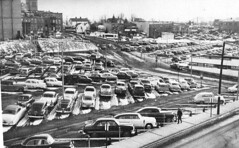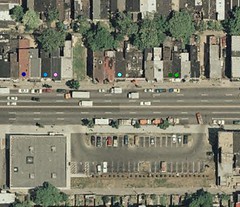Suburban building forms in the center city--Does this contribute to crime?
 Historic photo of shopping center parking lot demonstrates that there have been no significant steps forward in parking lot design over the past fifty years. (Photo from the Woodrow Wilson High School Alumni of Beckley, WV website. There are some great photos here...)
Historic photo of shopping center parking lot demonstrates that there have been no significant steps forward in parking lot design over the past fifty years. (Photo from the Woodrow Wilson High School Alumni of Beckley, WV website. There are some great photos here...)Right now, there is a thread on the Brookland email list about steps by the Police Department to address crime at the Brentwood Shopping Center, home to Giant and Home Depot, and a place where a couple people have been killed, and where many cars are stolen. As someone pointed out, crime happens where there are a lot of people, and I agree with this. (I also remember an interesting article a year or more ago about a community out west, in Utah maybe, that found its police department overburdened as a result of a Wal*Mart opening in its jurisdiction. See this story from the KUTV, Salt Lake City, website.)
Anyway, this is what I wrote:
In the right sidebar of my weblog, there are many website links, including four sites directly relevant to this thread: one is a website on CPTED--Crime Prevention Through Environmental Design, another is a legal review article on "Architecture as Crime Control," as well as the National Council on Crime Prevention (known for McGruff the crime dog), which publishes a number of excellent resources, and the Crime Reduction Website sponsored by the UK Home Office.
Clearly, from the perspective of safety in urban environments, traditional suburban forms do not make it. The suburban form is anti-thetical to eyes on the street, and this is perfectly exhibited in the Brentwood Center AND the Metro site. Plus those d*** parking lots are cesspools for windblown trash, dead plants, etc. It happens that I wrote a blog entry somewhat related to this wrt the Target development in Columbia Heights.
The blog entry isn't about crime, but it does discuss protecting and extending urban design in the city instead of acquiesing to suburban design. The crime at Brentwood Center (and the Metro site) are a result in part (imo) of the dominant suburban, car-centric nature of both.
The classic work in this field in the book Defensible Space by Oscar Newman, and his follow up book Creating Defensible Space. It's not a matter of creating gated communities, just putting the principles of urban design to work, rather than letting them slide.
 Aerial view of the Autozone parking lot, 1200 block of H Street NE, from the DC Guide/DC Government website.
Aerial view of the Autozone parking lot, 1200 block of H Street NE, from the DC Guide/DC Government website.



0 Comments:
Post a Comment
<< Home